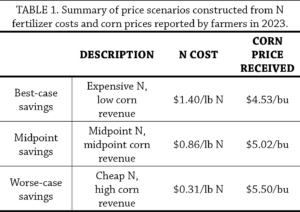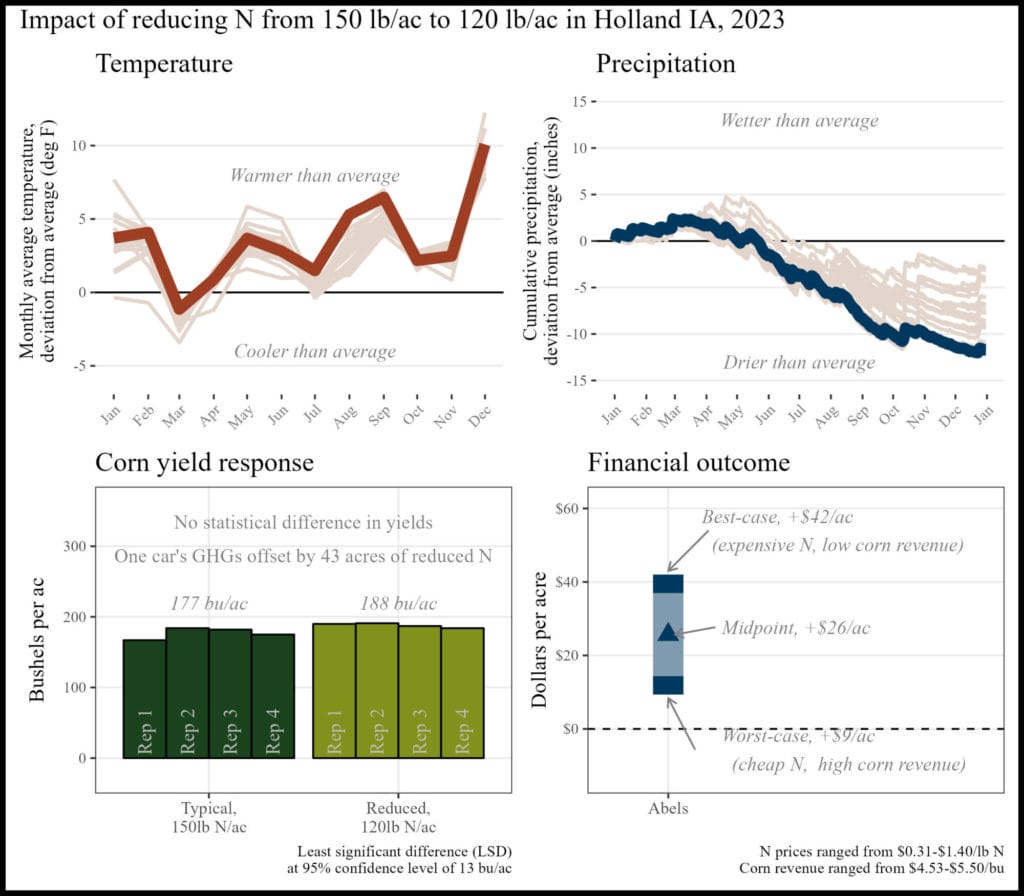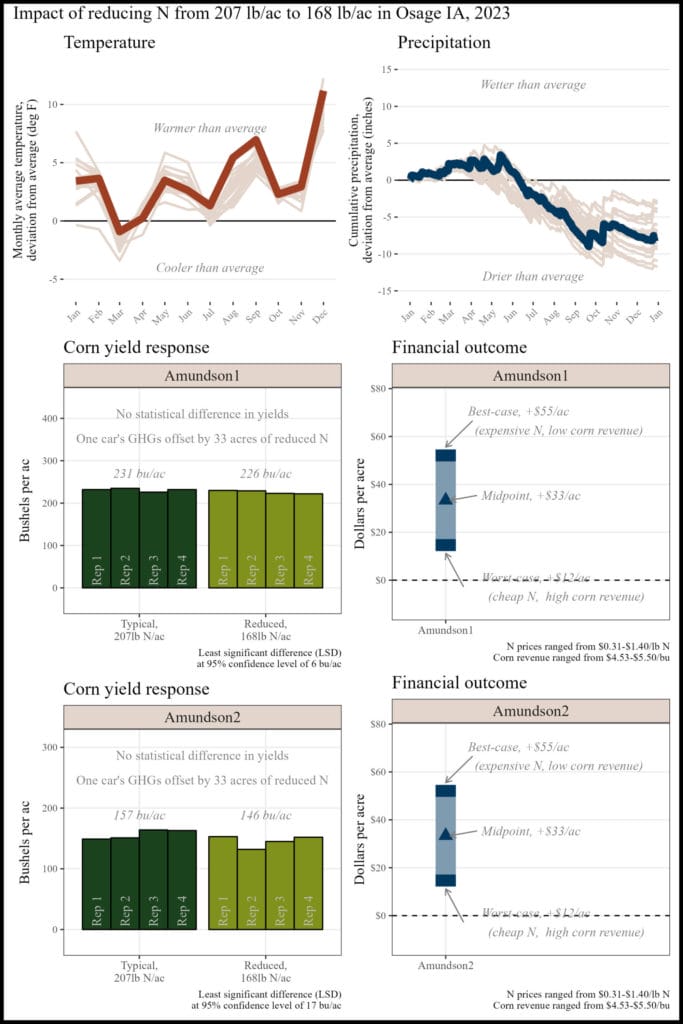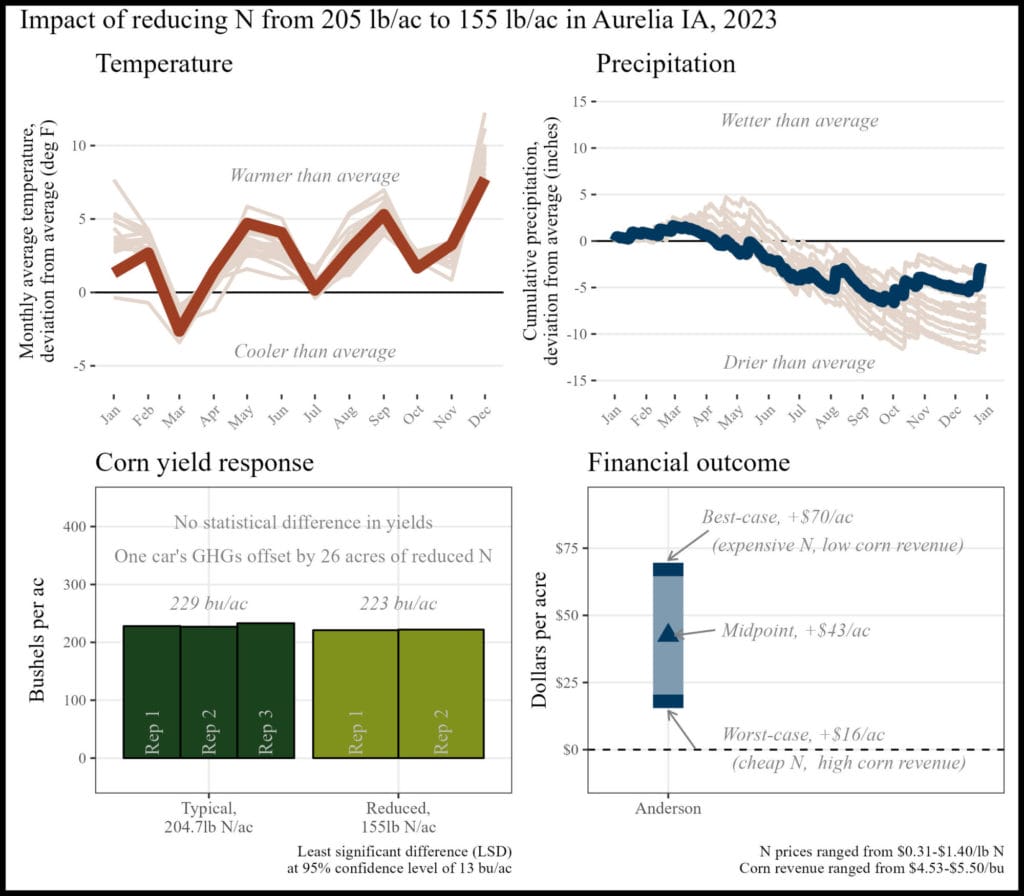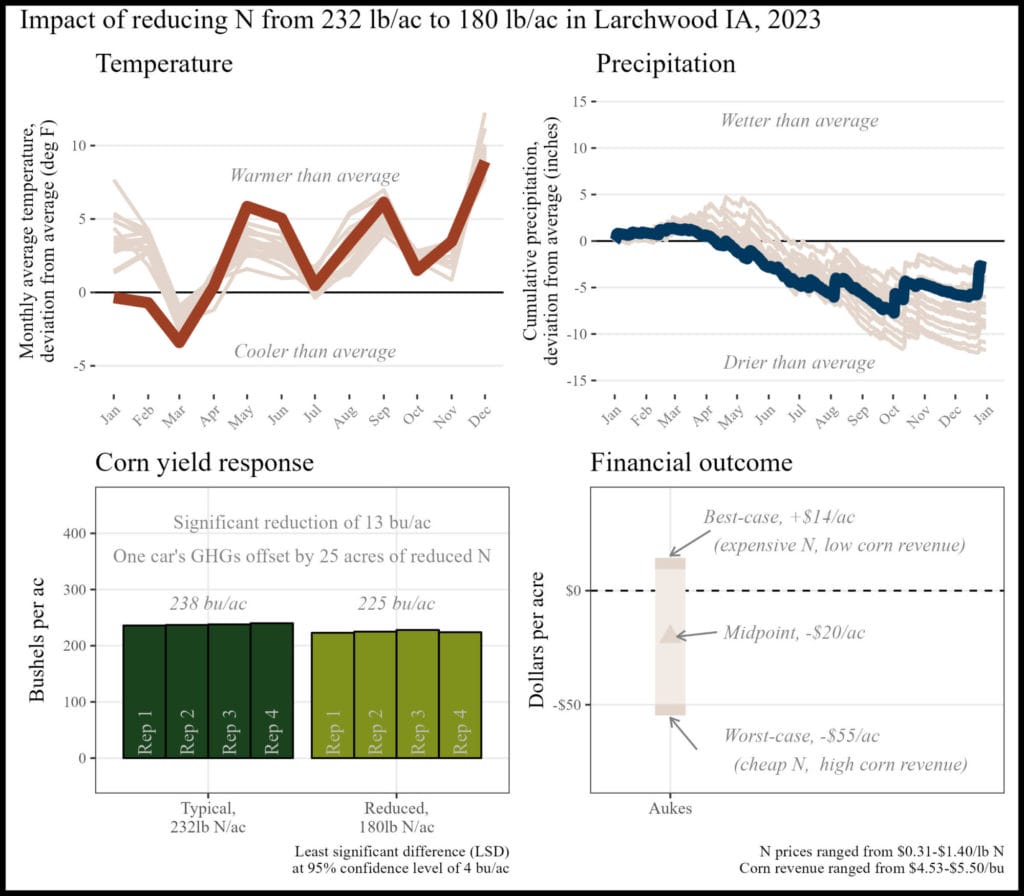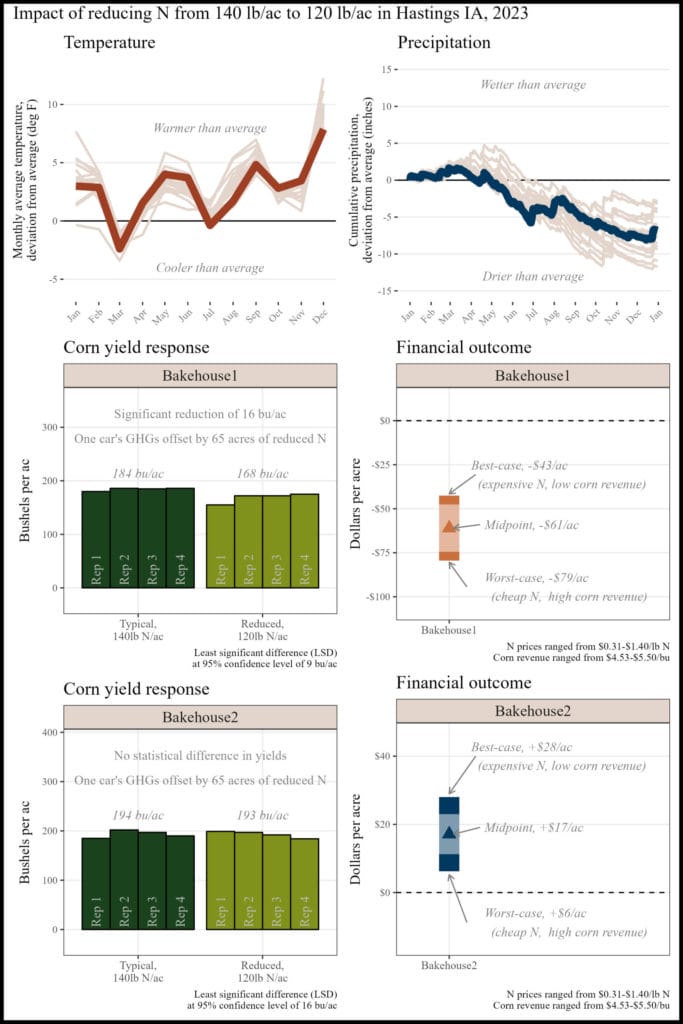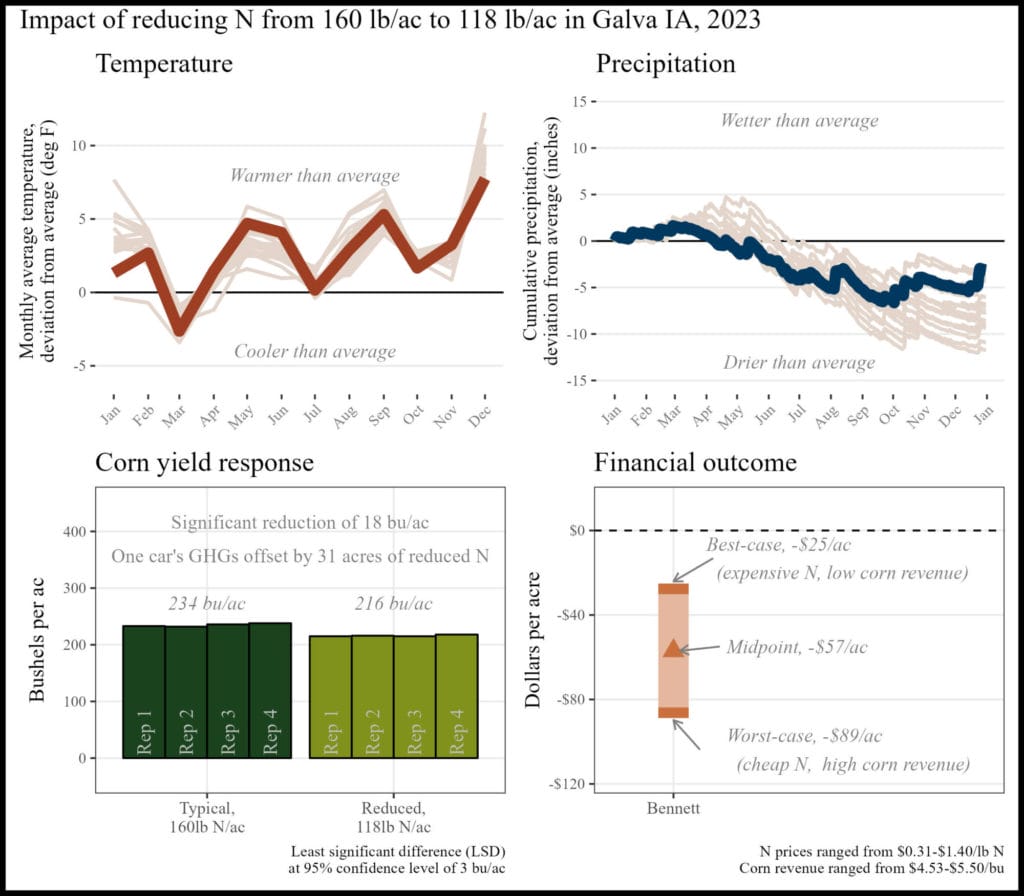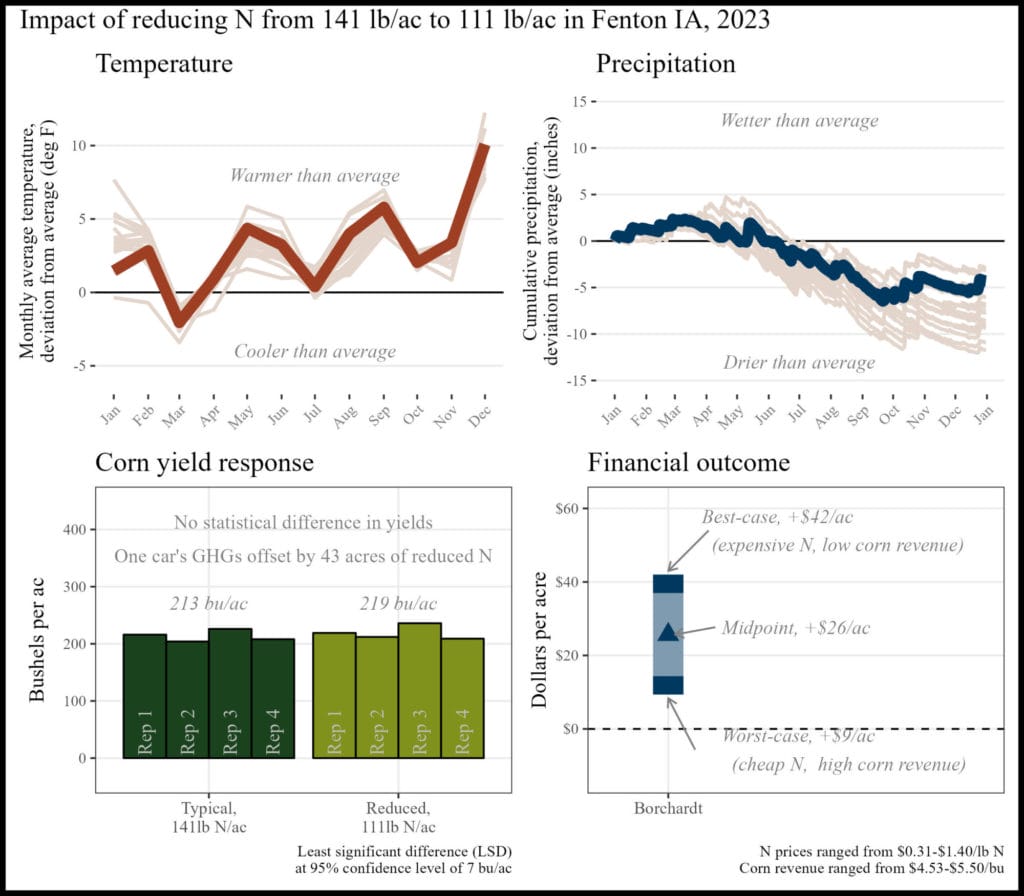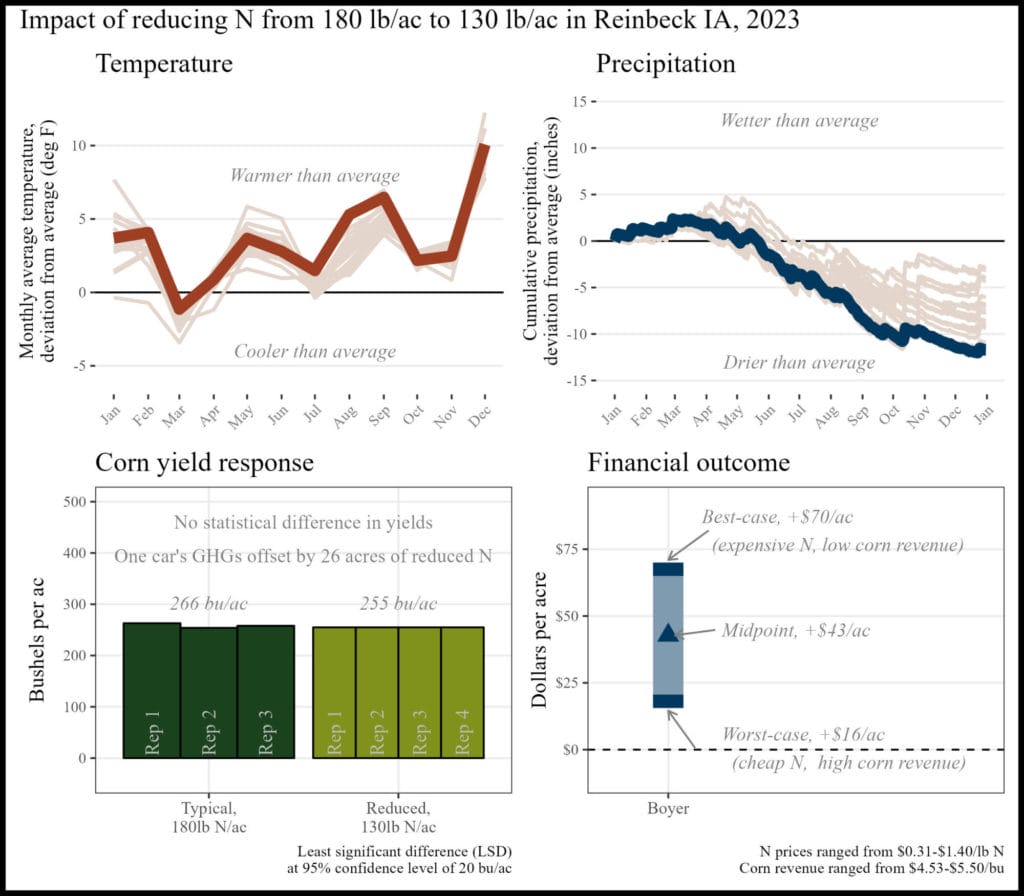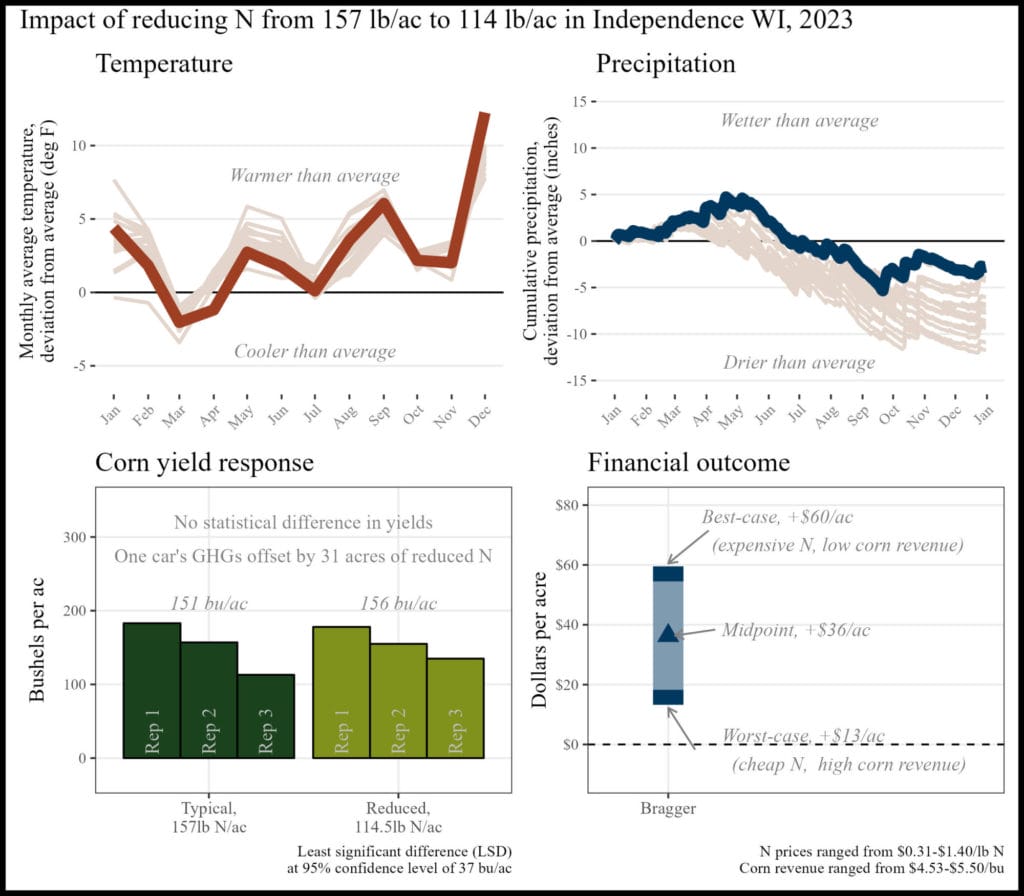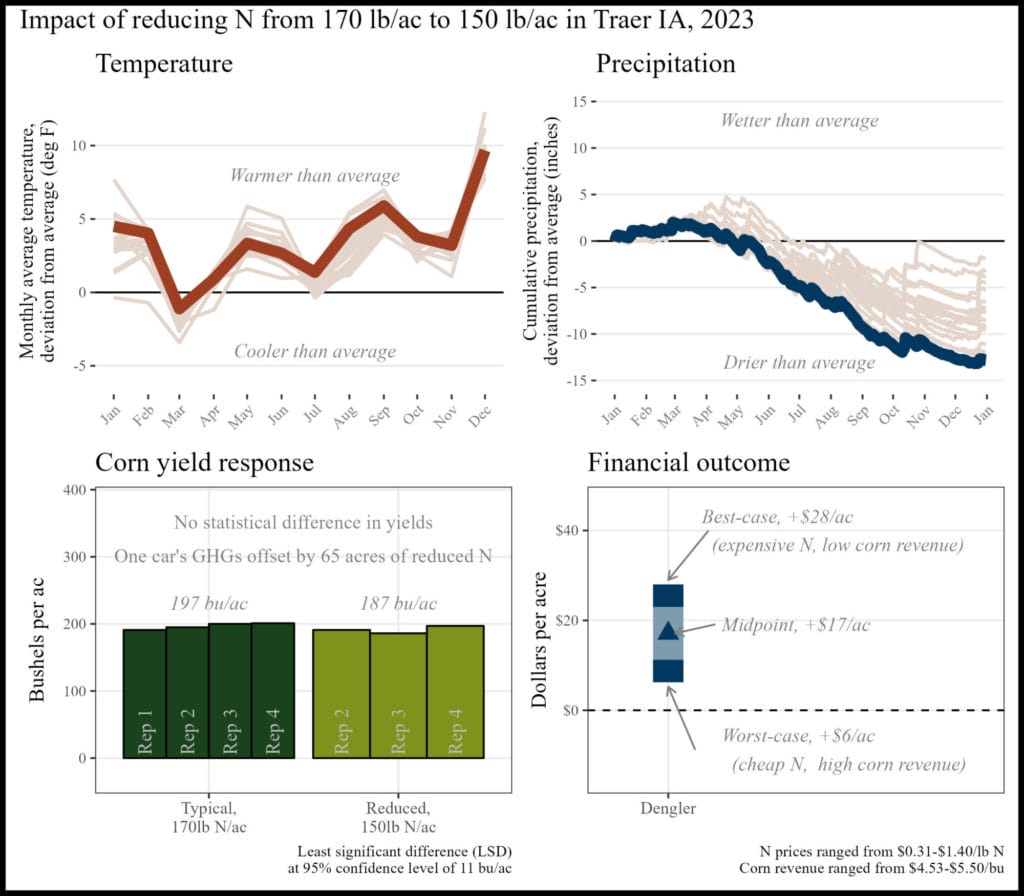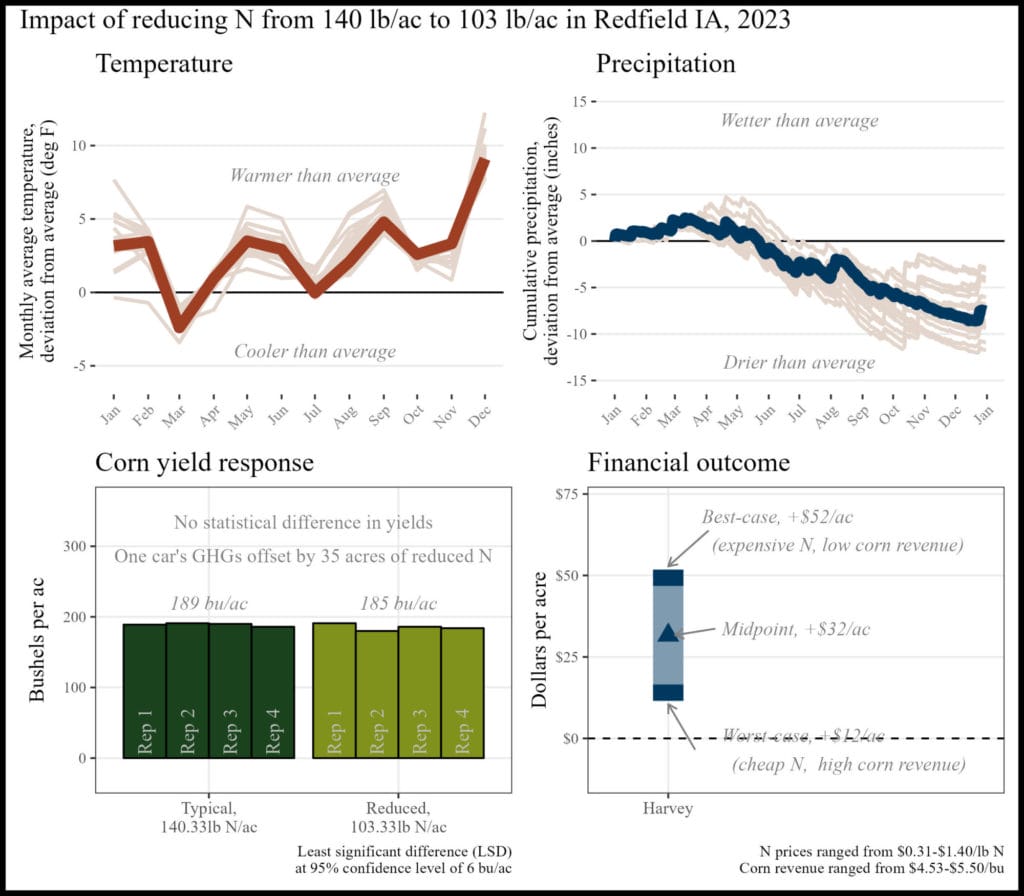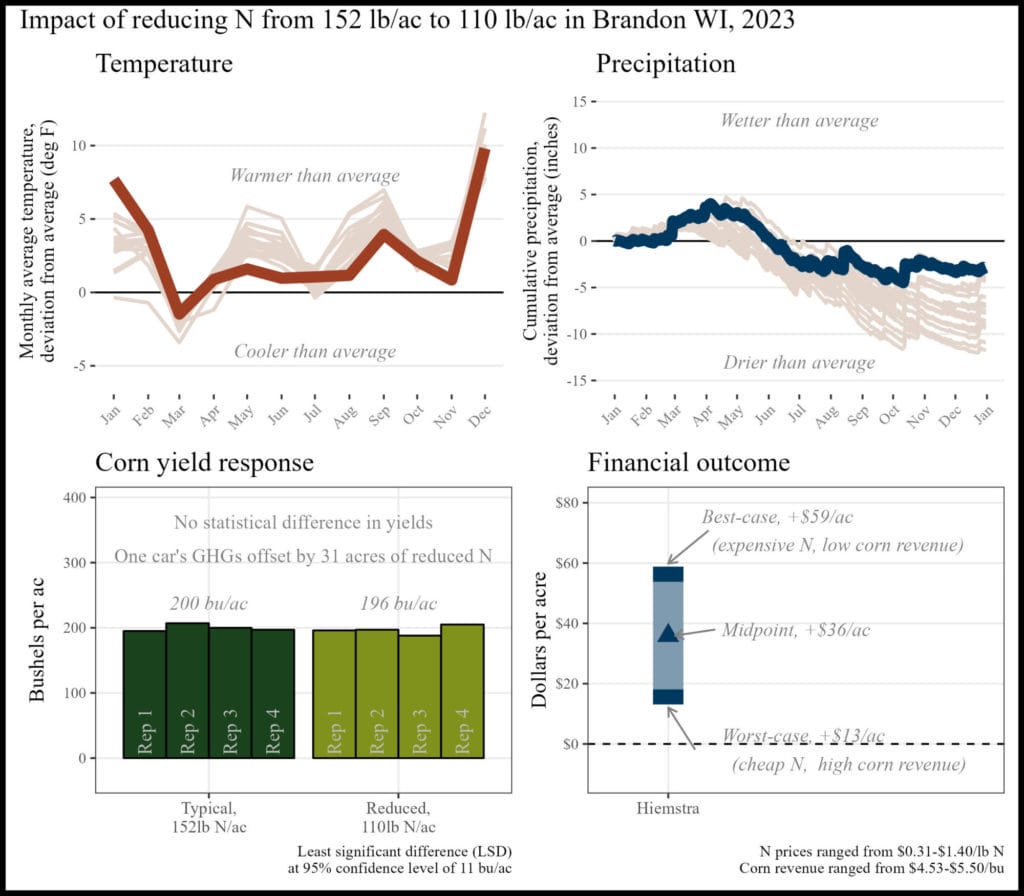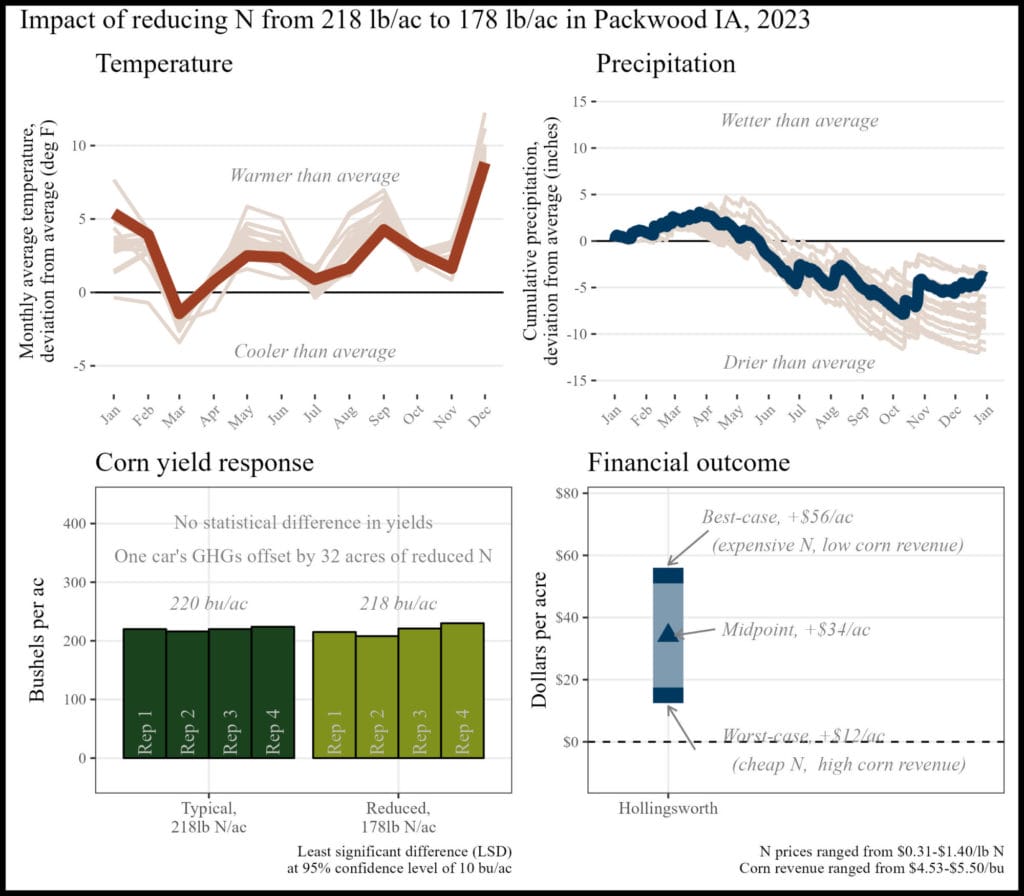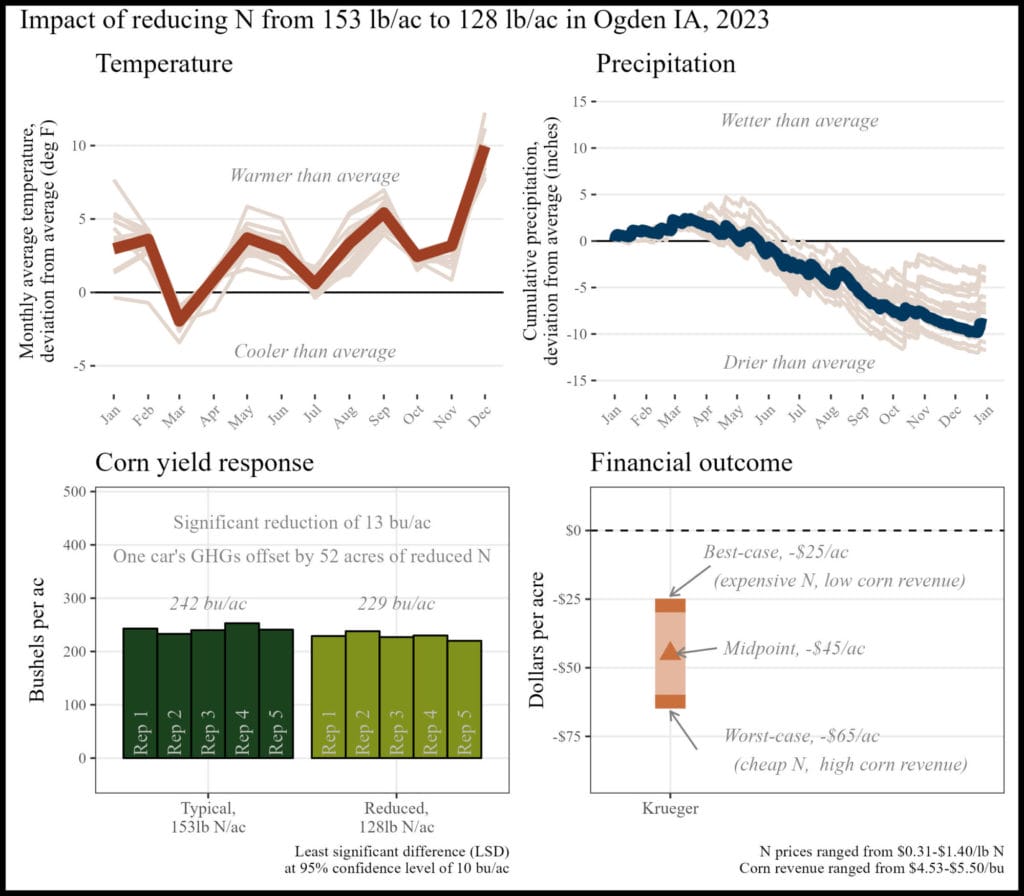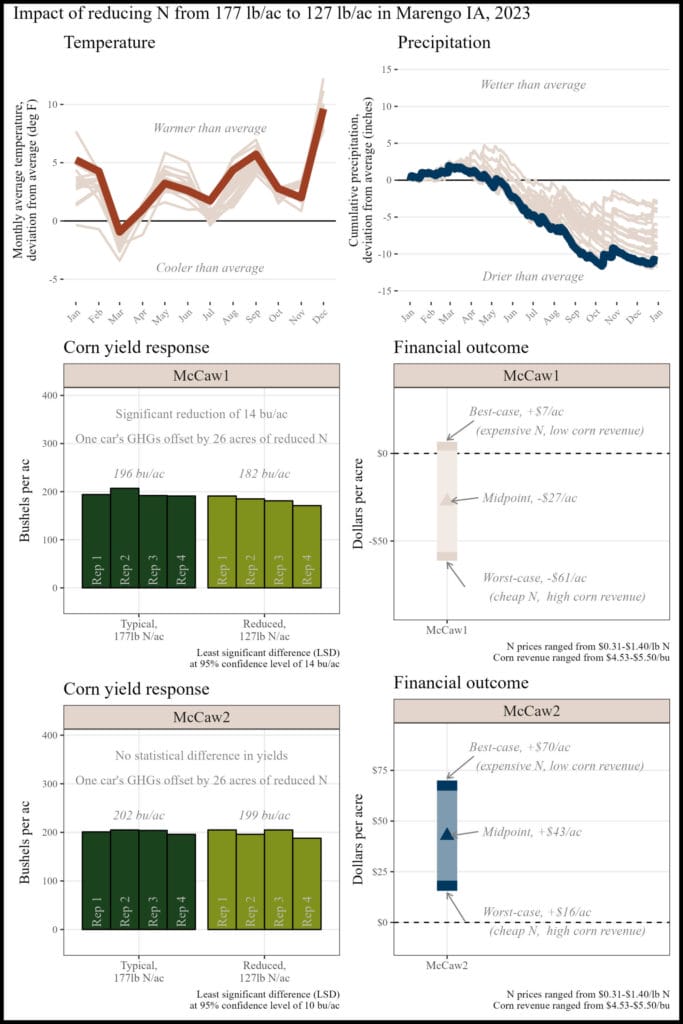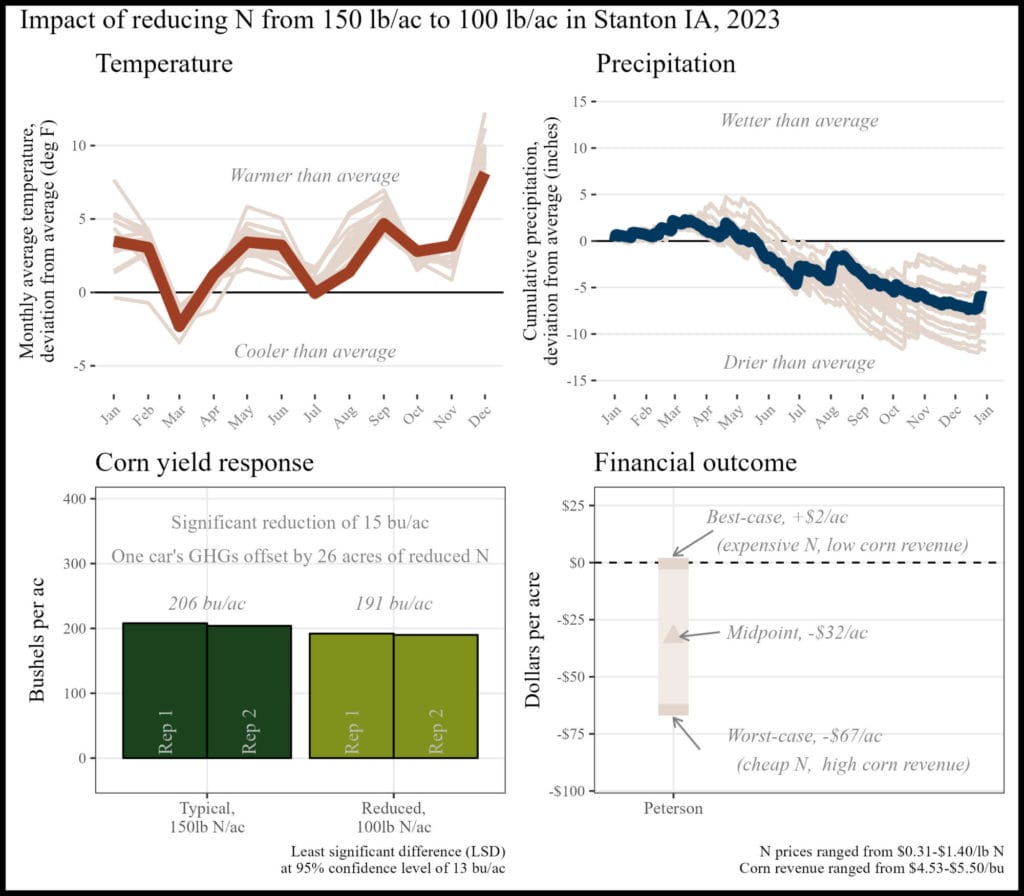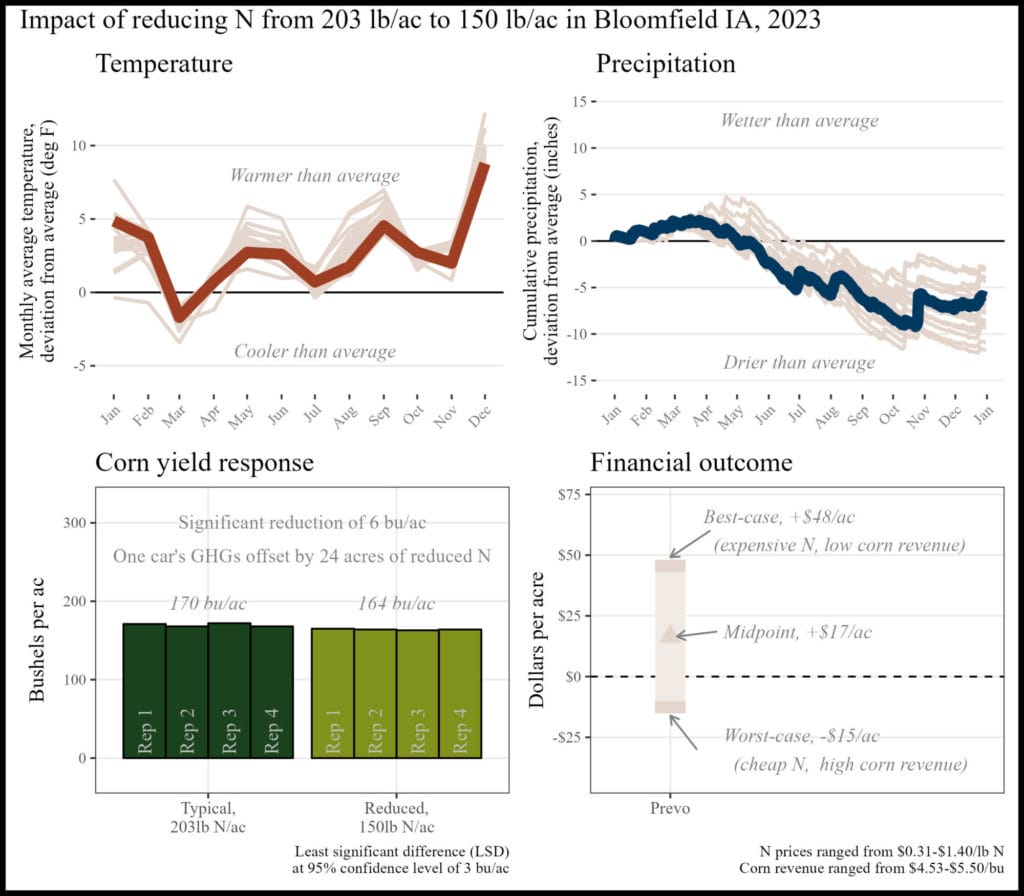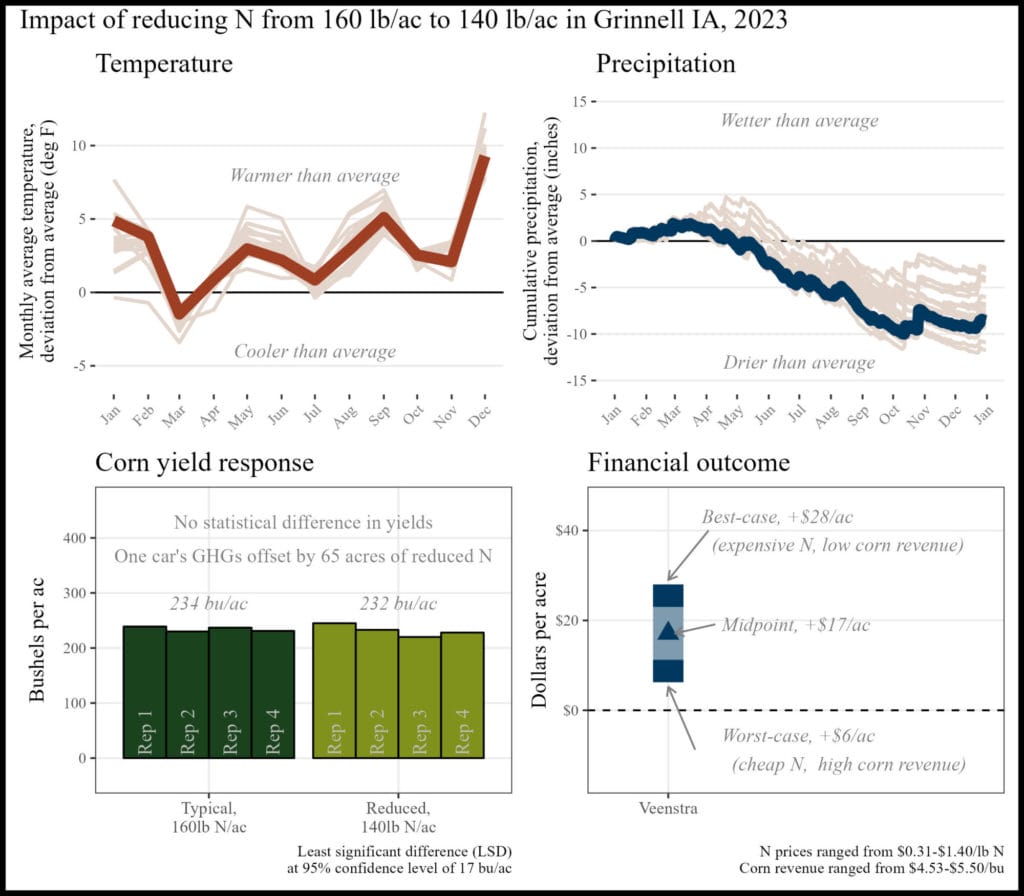This research was funded by USDA-NRCS, FFAR and Walton Family Foundation.
In a Nutshell:
- Nineteen farmers performed 22 replicated strip trials testing their typical nitrogen (N) rate against that rate reduced by an amount of their choosing.
- Farmers chose to test N reductions ranging from 20-60 lb N/ac (reducing 12-50% of typical rate).
- Most farms routinely used cover crops in the past five years (15), while some used a diversified crop rotation (4), applied manure (5) or incorporated grazing (4). Farms were predominantly in no-till with some occasionally including strip-till.
Key Findings:
- All sites experienced warmer-than-average and drier-than-average growing seasons.
- Nineteen of the 22 trials potentially saved money when reducing their N rates.
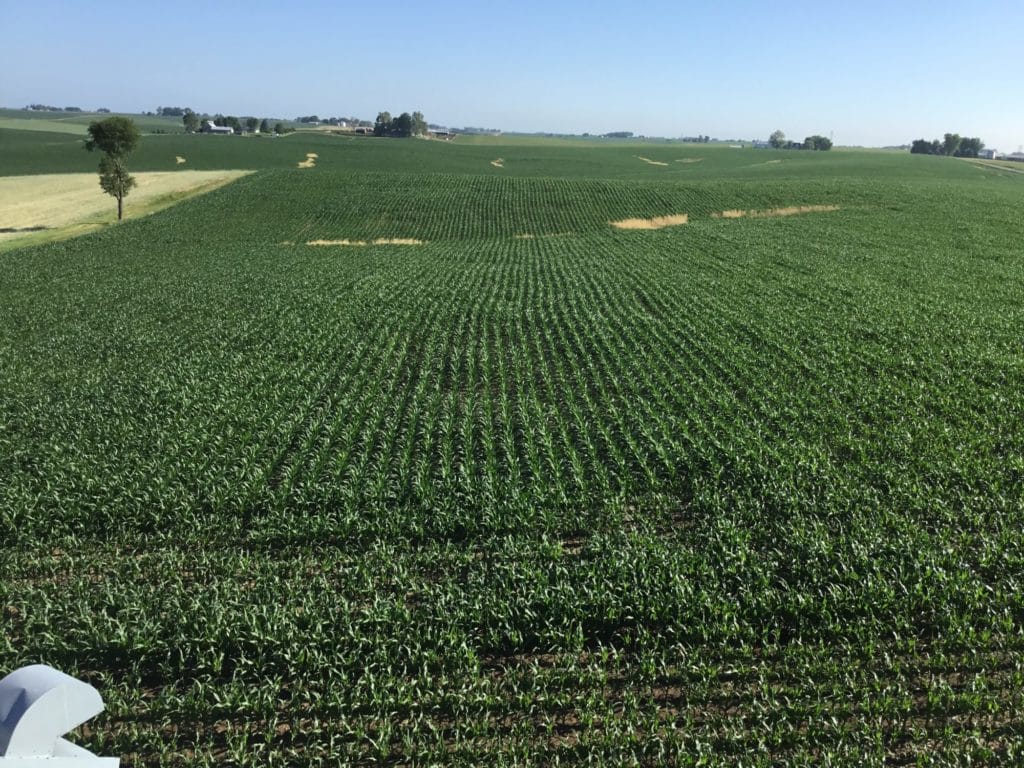
A high angle shot of Kevin Veenstra’s trial field on June 19, 2023. He saw no difference in corn yield and reaped financial savings by reducing his N rate by 20 lb N/ac. Veenstra has been using cover crops and no-till on his farm near Grinnell for over seven years.
Background
This newest round nitrogen fertilizer rate trials builds on trials conducted in Iowa in 2022 [1]. This year we expanded eligibility to the larger Midwest, and once again included farmers who self-identified as using soil health-promoting practices for at least five years. Using a replicated strip-trial design, farmers compared yields, finances and greenhouse gas emissions at their usual N rate with those observed at a reduced rate. Farmers chose their own reduction rates, while PFI staff encouraged farmers to be aggressive. One goal of the trial was to push farmers to explore N rates outside of their comfort zone.
If farmers can maintain corn yields and/or save money at the reduced N rate, results might spark confidence to reduce (or at least question) fertilizer rates going forward. “If I can arrive at a lower baseline N rate without reducing total production on farm, that is a significant opportunity for increased margin,” said Keaton Krueger at the onset of the trial. If the reduced N rate lowers corn yields and loses money, farmers will still have gained valuable information: They can be more confident that their typical rate is the right rate for their farm, but maybe new long-term practices could help reduce it in the future. Additionally, while individual trials are immensely useful for farmers, aggregating many trial results can provide a more powerful dataset to help farmers evaluate their N rates. Or, as Ross McCaw said, “[This project] will help myself and others gain more information on what practices are most profitable and better for the land.”
Methods
Design
Cooperating farms in 2023 were located across Iowa (17) and Wisconsin (2).
All farmers used two treatments:
- Typical – Their typical N fertilizer rate applied to a corn crop.
- Reduced – An N fertilizer rate less than the typical rate.
All treatments were replicated at least four times, resulting in a total of at least eight plots in each farmer’s trial (Figure 1).
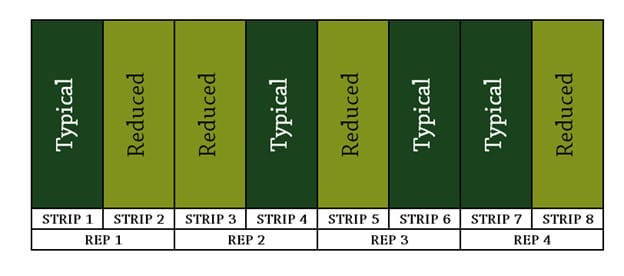
Figure 1. An example of a farmer’s treatment layout testing two nitrogen (N) fertilizer treatments for this trial. In 2023 strips averaged 39 feet wide and 1,275 feet long resulting in an average strip size of 1.1 acres.
Measurements
Farmers recorded the timing, type (chemical, organic), amount of N applied, and price paid per unit N for each treatment. Corn yields were measured and reported by each farmer, along with the percent moisture of the harvested grain. All yields were converted to 15.5% moisture for this report. Additionally, most farmers reported approximate prices received per bushel of corn.
Data Analysis
More details regarding methods of data analysis can be found in the Appendix T. Detailed Methods section at the end of this report.
Weather
To provide context for the results, weather data was downloaded from the National Aeronautics and Space Administration (NASA) Prediction of Worldwide Energy Resources (POWER) project (https://power.larc.nasa.gov/) for each farmer’s trial.
Yields
At each trial, differences in yields at the typical and reduced N rate were assessed for statistical significance using a statistical model. The model tested for the effect of the N treatment, while accounting for possible natural yield gradients in the field and, in some cases, missing data. Significance was assigned using a 95% confidence level threshold, meaning we are 95% sure the differences observed were ‘real’.
Finances
Nitrogen prices depend on several factors including the form of N, the timing of the purchase and the location of the purchase. Similarly, the price received for corn fluctuates throughout the year. Due to this variation, as well as the limited control farmers have over the price paid for N and the price received for corn, we used three price scenarios to compare financial outcomes of the typical and reduced N treatments: best-case savings, midpoint savings, and worst-case savings (Table 1). Using the data provided by the farmers, we took the lowest and highest farmer reported prices for the N source they adjusted to create their two rate treatments, and the lowest and highest reported price received for corn – these values were used to construct the price scenarios.
A partial budget using a given price scenario was performed for each treatment. Costs were estimated as the amount of N applied in that treatment multiplied by the assumed N cost, which depended on the scenario (Table 1). If the yields of each treatment were statistically different, each treatment’s yields were used for corn revenue calculations. If there was no statistical difference in treatment yields, the overall mean yield for the trial was used for corn revenue calculations. Partial net revenue for each treatment was calculated by subtracting the costs (N applied multiplied by N cost) from the revenue (yield multiplied by corn price). The difference between partial net revenues for the ‘reduced’ and ‘typical’ treatments were calculated and reported. A positive value therefore represents financial savings at the reduced N rate. This process was done separately for the three price scenarios.
Greenhouse gas emissions
When a farmer reduces the amount of chemical N fertilizer applied to a field, two sources of greenhouse gas (GHG) emissions associated with crop production are avoided: the GHGs (expressed as carbon dioxide equivalents, CO2e) released during fertilizer manufacturing processes, and the nitrous oxide (N2O) released from the soil due to biological processes driven by N application. To convert N2O to CO2e, a 100-year time horizon was assumed based on Intergovernmental Panel on Climate Change (IPCC) recommendations [2]. Over the period of 100-years, one pound of N2O will have a forcing potential equal to 298 pounds of CO2e [2].
The CO2e released during fertilizer manufacturing was estimated using two values: (1) energy used to manufacture nitrogen fertilizers as reported from the 2022 GREET® (Greenhouse gases, Regulated Emissions, and Energy use in Technologies) model, developed by the Department of Energy’s Argonne National Laboratory (58 MJ/kg N) [3], and (2) the amount of CO2e released per MJ of energy used as reported by the Environmental Protection Agency [4]. The avoided N2O as a result of decreased N application was estimated using the IPCC methodologies for both direct and indirect agricultural N2O emissions [5]. All above calculations can be simplified to a constant conversion factor: the pounds of N reduced per acre from the typical rate can be multiplied by 7.82 to get pounds of CO2e avoided per acre.
The acres needed to reduce a given amount of N application to equate to the emissions generated by a single United States (US) vehicle were calculated using the EPA’s estimates for vehicle emissions [6]. The EPA uses statistics to represent an average US gasoline vehicle (22 miles per gallon, driven 11,500 miles per year), and estimates the emissions from one vehicle using those values (estimated to be 10,141 lb CO2e/year) [6].
Results and Discussion
Treatments
Nineteen farmers conducted a total of 22 independent N trials. The chosen treatments reflected the diversity in farming systems, with typical N rates ranging from 120-232 lb N/ac and reduced N rates ranging from 60-180 lb N/ac (Figure 2). When averaged over all trials, typical and reduced N rate treatments were 170 lb N/ac and 131 lb N/ac, respectively, for an average reduction of 39 lb N/ac.
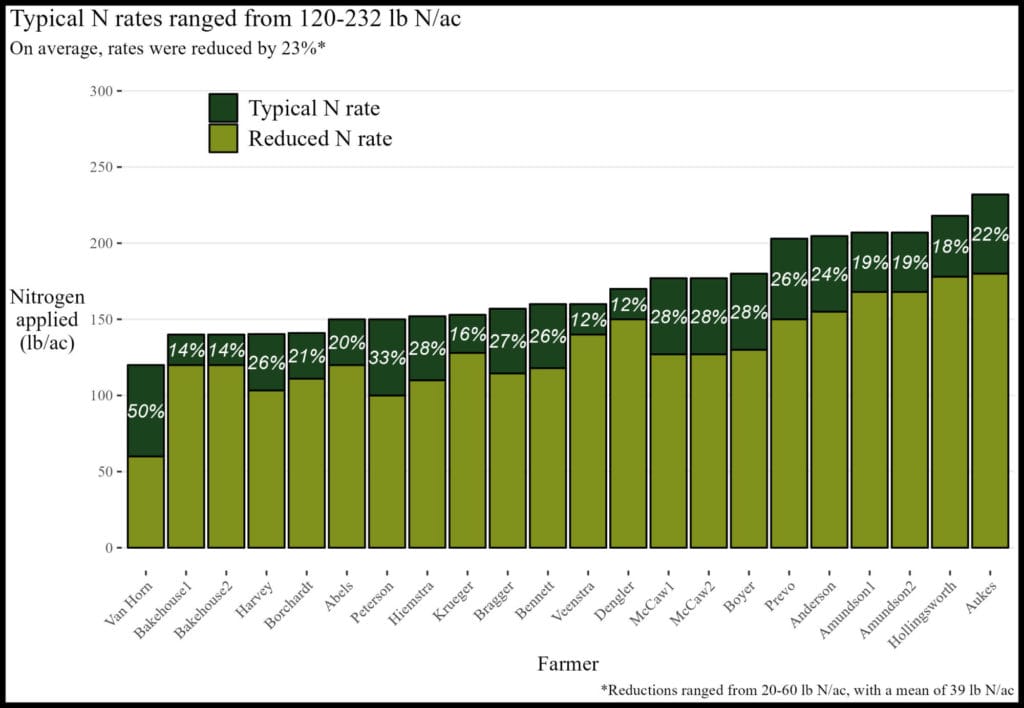
Figure 2. Twenty-two trials tested two nitrogen (N) application treatments in the 2023 growing season. A cooperator’s typical N rate (dark green bar), chosen reduced N rate (light green bar), and the reduction relative to the typical rate (white text). Click to enlarge.
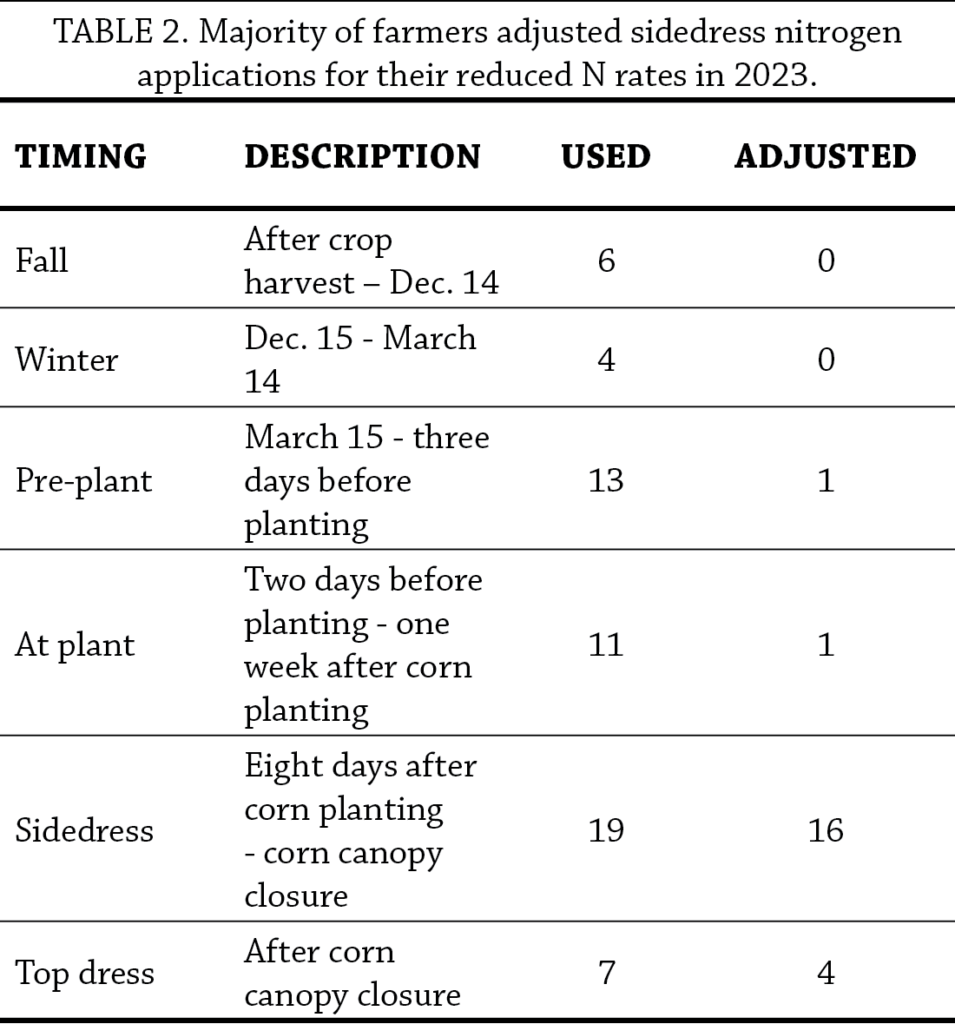 Farmers used a variety of N application timings in their production systems, with most using sidedressing. For the reduced N treatment, 16 of the 22 trials chose to reduce N rates during sidedressing, while holding other applications constant (Table 2).
Farmers used a variety of N application timings in their production systems, with most using sidedressing. For the reduced N treatment, 16 of the 22 trials chose to reduce N rates during sidedressing, while holding other applications constant (Table 2).
Weather
All 22 trial locations saw progressively warmer- and drier-than-average growing seasons (Figure 3).
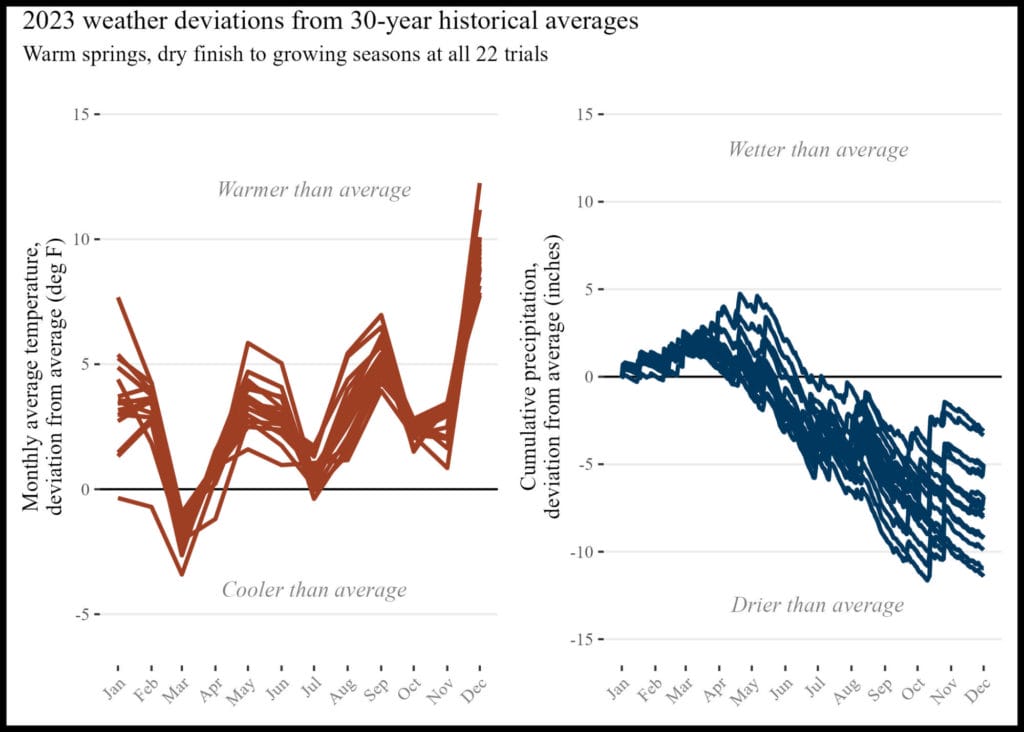
Figure 3. Individual cooperator site weather compared to 30-year historical averages for that site. (Left) Average monthly air temperature deviations and (right) cumulative precipitation deviations.
Overall, although all sites experienced a hot and dry growing season, the diversity in N application amounts, sources, methods, and timing as well as cropping system history contributed to varied outcomes for each cooperator. Click to enlarge.
Yields
Seven of the 22 trials (32%) saw statistically significant reductions in corn yields at the reduced N rate. However, it is important to note that statistical significance in yield declines is not related to financial outcomes (Figure 4, left panel). Statistical significance is a function of both the magnitude of the difference in treatments, as well as how variable the yields in the field were. It helps readers and farmers decide how much to ‘trust’ the yield changes, and therefore how to calculate financial outcomes. For example, Kevin Prevo’s reduced N treatment yielded 5.8 bu/ac less than his typical N treatment corn, and the reduction was statistically significant, so he can be confident that reduction was real. For comparison, Alec & Rachel Amundson’s first trial (Amundson1) saw a similar reduction in corn yield at the reduced N rate as Prevo (5.2 bu/ac), but the reduction was not statistically significant, meaning there was more variation between strips at the Amundsons’ trial location compared to Prevo’s, and they may question how ‘real’ the yield reduction was. While Prevo and the Amundsons may have different conclusions about the impact of the reduced N treatment on corn yields, they both saw potential financial savings at the reduced N rate (Figure 4, right panel).
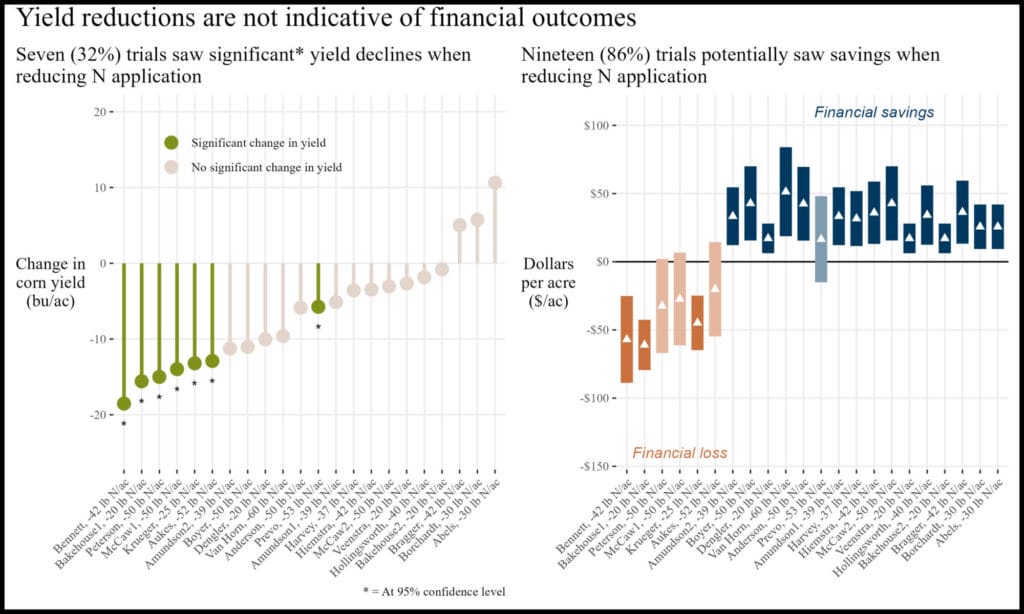
Figure 4. Impact of reducing N rates on corn yields and finances. The x-axis labels present each farmer and the amount they reduced their typical N rate to achieve the reduced N treatment (see Figure 3), ordered by their change in corn yield when reducing N rates. (Left) The y-axis presents the change in corn yields in the reduced N treatment relative to yields in the typical N treatment, with the color indicating whether the change was statistically significant (green with *) or not significant (tan). (Right) The x-axis presents the farmers, still ordered by their yield change, and the y-axis presents the financial outcome in the reduced N treatment relative to the typical N treatment assuming best-case (top of vertical bar), worst-case (bottom of bar) and midpoint 2023 price scenarios (white triangles). Blue bars indicate a financial savings in the midpoint price scenario, orange bars indicate a financial loss in the midpoint price scenario, and lighter colored bars indicate the financial outcome was sensitive to the price scenario considered. Click to enlarge.
Finances
The financial outcomes of reducing applied N varied by trial and price scenario (Figure 4 right panel). Fifteen trials saved money in the reduced N treatment compared to the typical N treatment regardless of the price scenario considered (see Table 1). An additional four trials showed potential for savings under at least one price scenario. For example, in the best-case scenario Terry Aukes saved $14/ac, but lost $20/ac in the mid-point scenario and lost $55/ac in the worst-case scenario. Three trials (Bennett, Bakehouse1, and Krueger) lost money in every price scenario. In this set of trials, the worst potential financial loss observed was $89/ac (Bennett’s worst-case scenario), and the best potential financial savings was $84/ac (Van Horn’s best-case scenario).
Greenhouse gas emissions
Reducing N applications will always reduce GHG emissions associated with corn production. In 2023, avoided GHGs ranged from 150-470 lb CO2e/ac. However, using midpoint price scenarios (Table 1), in 16 trials (73%) those avoided emissions co-occurred with a financial savings, while in six trials the reduced GHG emissions came at a financial loss (Figure 5, left panel).
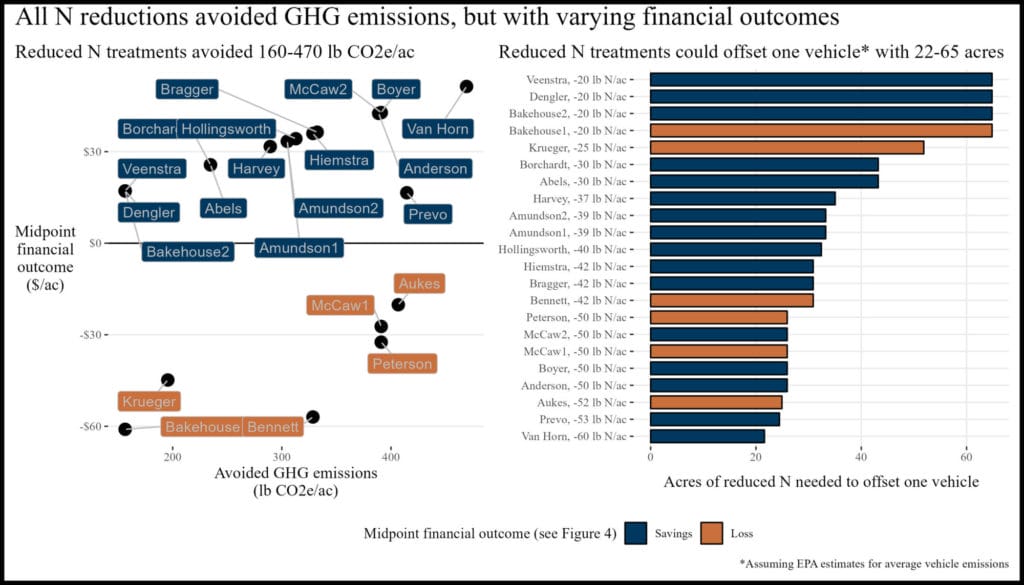
Figure 5. Some farmers lost money while reducing GHG emissions, but the majority (73%) potentially saved money. (Left) All trials avoided GHG emissions and 16 of the 22 trials also saved money assuming mid-point price scenarios (dark blue), while six trials lost money in the mid-point price scenario (orange). (Right) Based on the Environmental Protection Agency [6] estimated GHG emissions for one average gasoline vehicle (22.2 miles per gallon, driven 11,500 miles per year), reducing N applications by 20-60 lb/ac would offset one vehicle’s emissions if utilized on 22-65 acres. Click to enlarge.
To put these avoided GHG emissions into perspective, one vehicle emits around 10,000 lb CO2e/year [6]. Using each trial’s selected N reduction, we back-calculated how many acres the farmer would need to apply their reduced N treatment to offset one vehicle. For example, John Van Horn chose to reduce his typical N application by 60 lb/ac. Van Horn could offset one vehicle’s emissions by using his reduced N rate on 22 acres (Figure 5, right panel). Using his midpoint price scenario savings of $51/ac (Figure 4, right panel) he would potentially also save around $1,000. However, if, for example, Mark Peterson applied his reduced N treatment (50 lb/ac reduction) to 26 acres, he could offset one vehicle’s emissions but would also lose $32/ac, or around $800.
Conclusions and Next Steps
Of the 22 trials conducted, nineteen potentially saved money in the reduced N treatment (any part of bars above the zero line in the right panel of Figure 4). More specifically, 15 trials saved money under all three price scenarios; one trial saved money in two of the price scenarios; and three trials saved money only under the best-case price scenario. Three trials likely lost money in the reduced N treatment under all price scenarios.
All trials avoided GHG emissions by reducing N fertilizer and 16 of the 22 trials could do so while also saving money under the mid-point price scenario (left panel of Figure 5). To offset the emissions of a single vehicle, those farmers would have to apply their reduced N rate to only 22–65 acres on their farms. That is a climate-smart win-win for farming and the environment.
Most of the participating farmers remain motivated to continue conducting these trials to, as Alec Amundson put it, “continue to fine tune N rates.” The project has also gained the attention of other farmers who wish to join the effort in coming years. All signs point to more farmers putting their soils to the test by reducing N fertilizer applications in the interest of improved finances and environmental quality.
Appendix A. Fred Abels; Holland, IA
The financial outcome at the reduced N rate was likely a financial savings compared to the typical N rate. A 30 lb N/ac reduction saved money this year, and, when applied to at least 43 acres, could offset the average annual GHGs of one vehicle.
Historical cropping system (5 year): No-till corn, soybeans, cereal rye cover crop
Previous crop: Soybeans, cereal rye cover crop
Strip size: 1.8 ac
Corn planting/harvest date: May 18/Nov. 6
Corn row spacing/planting density: 30 in.; 36,000 seeds/ac
Nitrogen sources and timing: Chemical sources; preplant and sidedress
Appendix B. Alec and Rachel Amundson; Osage, IA
“We continue to look at crop rotation and the benefits of small grains and legume covers.”
The financial outcome at the reduced N rate in both fields was likely a financial savings compared to the typical N rate. A 39 lb N/ac reduction saved money this year, and, when applied to at least 33 acres, could offset the average annual GHGs of one vehicle.
Historical cropping system (5 year): No-/strip-till corn, soybeans, oats, rye and clover cover crops
Previous crop: 1) Oats, red clover cover crop; 2) Corn
Strip size: 1) 1.6 ac; 2) 1.7 ac
Corn planting/harvest date: 1) May 4/Oct. 1; 2) May 3/Oct. 5
Corn row spacing/planting density: 30 in.; 1) 33,500 seeds/ac; 2) 32,500 seeds/ac
Nitrogen sources and timing: Chemical sources; fall, at planting, sidedress, topdress
Appendix C. Nathan Anderson; Aurelia, IA
“Dry conditions + above average N costs = negative return on investment for additional N applied.”
The financial outcome at the reduced N rate was likely a financial savings compared to the typical N rate. A 50 lb N/ac reduction saved money this year, and, when applied to at least 26 acres, could offset the average annual GHGs of one vehicle.
Historical cropping system (5 year): No-/strip-till corn, soybeans, small grain and brassica cover crops, grazing corn stalks
Previous crop: Soybeans, cereal rye and rapeseed cover crop
Corn planting/harvest date: Apr. 11/Oct. 20
Corn row spacing/planting density: 30 in.; 35,000 seeds/ac
Nitrogen sources and timing: Chemical; fall, topdress
Appendix D. Terry Aukes; Larchwood, IA
The financial outcome at the reduced N rate was likely a financial loss compared to the typical N rate. A 52 lb N/ac reduction was likely too large this year, but there may be potential for financial savings with a smaller N reduction.
Historical cropping system (5 year): No-till corn, soybeans, cereal rye cover crop
Previous crop: Soybeans
Strip size: 1,200 ft long
Corn planting/harvest date: May 3/Oct. 28
Corn row spacing/planting density: 30 in.; 36,000 seeds/ac
Nitrogen sources and timing: Chemical; at planting, sidedress
Appendix E. Jon Bakehouse; Hastings, IA
“Analyzing two sections of the same field separately really shed light on how N can make a larger difference in tougher soils. Also, good grief, 193 bu/ac on 120 lbs of applied N? Wow.”
In field 1, the financial outcome at the reduced N rate was likely a financial loss.
In field 2, the financial outcome at the reduced N rate was likely a financial savings compared to the typical N rate. A 20 lb N/ac reduction saved money this year, and, when applied to at least 65 acres, could offset the average annual GHGs of one vehicle.
Historical cropping system (5 year): No-till corn, soybeans, cereal rye cover crop, fall grazing
Previous crop: Soybeans
Strip size: 1) 0.8 ac; 2) 1.6 ac
Corn planting/harvest date: May 1/Sept. 28
Corn row spacing/planting density: 30 in.; 34,000 seeds/ac
Nitrogen sources and timing: Chemical; preplant, sidedress
Appendix F. Sam Bennett; Galva, IA
“Opposite results from last year’s trial, so made it clear that we need multiple years of data to dial in a better rate.”
The financial outcome at the reduced N rate was likely a financial loss compared to the typical N rate. A 42 lb N/ac reduction was likely too large this year.
Historical cropping system (5 year): No-/strip-till corn, soybeans, cereal rye cover crop
Previous crop: Soybeans
Strip size: 0.8 ac
Corn planting/harvest date: May 10/Oct. 22
Corn row spacing/planting density: 30 in.; 36,000 seeds/ac
Nitrogen sources and timing: Chemical; preplant, sidedress
Appendix G. Vaughn Borchardt; Fenton, IA
“Will not go above 140 lb N/ac but not comfortable with less than 100 lb N/ac.”
The financial outcome at the reduced N rate was likely a financial savings compared to the typical N rate. A 30 lb N/ac reduction saved money this year, and, when applied to at least 43 acres, could offset the average annual GHGs of one vehicle.
Historical cropping system (5 year): No-till corn, soybeans
Previous crop: Soybeans
Strip size: 0.7 ac
Corn planting/harvest date: Apr. 29/Sept. 29
Corn row spacing/planting density: 30 in.; 33,000 seeds/ac
Nitrogen sources and timing: Chemical; Fall, at planting, sidedress
Appendix H. Jack Boyer; Reinbeck, IA
“I will continue with methods to further reduce my N input.”
The financial outcome at the reduced N rate was likely a financial savings compared to the typical N rate. A 50 lb N/ac reduction saved money this year, and, when applied to at least 26 acres, could offset the average annual GHGs of one vehicle.
Historical cropping system (5 year): No-till corn, soybean, cereal rye cover crop
Previous crop: Soybean, cereal rye cover crop
Strip size: 0.4 ac
Corn planting/harvest date: May 16/Nov. 6
Corn row spacing/planting density: 30 in.; 35,000 seeds/ac
Nitrogen sources and timing: Chemical; preplant, at planting, sidedress
Appendix I. Joe Bragger; Independence, WI
The financial outcome at the reduced N rate was likely a financial savings compared to the typical N rate. A 43 lb N/ac reduction saved money this year, and, when applied to at least 31 acres, could offset the average annual GHGs of one vehicle.
Historical cropping system (5 year): No-till corn, soybeans, cereal rye cover crop
Previous crop: Soybeans, cereal rye cover crop
Strip size: 1.7 ac
Corn planting/harvest date: May 20/Nov. 20
Corn row spacing/planting density: 30 in.; 34,400 seeds/ac
Nitrogen sources and timing: Organic, chemical; winter, at planting, sidedress
Appendix J. Sean Dengler; Traer, IA
“I suspected the typical rate was too high, but I was pleasantly surprised at how much I saved per acre with the reduced rate.”
The financial outcome at the reduced N rate was likely a financial savings compared to the typical N rate. A 30 lb N/ac reduction saved money this year, and, when applied to at least 65 acres, could offset the average annual GHGs of one vehicle.
Historical cropping system (5 year): Tillage and strip-till; Seed corn, soybeans, corn
Previous crop: Soybeans
Strip size: 0.5 ac
Corn planting/harvest date: May 3/Oct. 17
Corn row spacing/planting density: 30 in.; 34,000 seeds/ac
Nitrogen sources and timing: Chemical; preplant, sidedress, topdress
Appendix K. Robert Harvey; Redfield, IA
“This trial is one step in finding the best economic rate of N.”
The financial outcome at the reduced N rate was likely a financial savings compared to the typical N rate. A 37 lb N/ac reduction saved money this year, and, when applied to at least 35 acres, could offset the average annual GHGs of one vehicle.
Historical cropping system (5 year): No-till corn, soybeans, cereal rye cover crop
Previous crop: Soybeans and cereal rye cover crop
Strip size: 0.4 ac
Corn planting/harvest date: May 2/Oct. 9
Corn row spacing/planting density: 30 in.; 32,000 seeds/ac
Nitrogen sources and timing: Chemical; winter, at planting, sidedress
Appendix L. Josh Hiemstra; Brandon, WI
“It was the third time I completed a trial with N. I now have enough confidence in my soil health program to free myself from unnecessary costs and passes.”
The financial outcome at the reduced N rate was likely a financial savings compared to the typical N rate. A 42 lb N/ac reduction saved money this year, and, when applied to at least 31 acres, could offset the average annual GHGs of one vehicle.
Historical cropping system (5 year): Minimum and vertical tillage; corn, soybeans, alfalfa
Previous crop: Corn
Corn planting/harvest date: May 11/Oct. 19
Corn row spacing/planting density: 30 in.; 32,000 seeds/ac
Nitrogen sources and timing: Organic, chemical; preplant, at-planting, sidedress, topdress
Appendix M. J.D. Hollingsworth; Packwood, IA
“I don’t like to make big changes based off of one year, but seeing these results will definitely get me to try reduced rates again.”
The financial outcome at the reduced N rate was likely a financial savings compared to the typical N rate. A 40 lb N/ac reduction saved money this year, and, when applied to at least 32 acres, could offset the average annual GHGs of one vehicle.
Historical cropping system (5 year): No-till corn, soybeans; cereal rye, turnip, radish cover crops
Previous crop: Soybeans and cereal rye, turnip, radish cover crops
Strip size: 0.6 ac
Corn planting/harvest date: May 1/Oct. 16
Corn row spacing/planting density: 30 in.; 34,000 seeds/ac
Nitrogen sources and timing: Organic, chemical; fall, preplant, at planting
Appendix N. Keaton Krueger; Ogden, IA
The financial outcome at the reduced N rate was likely a financial loss compared to the typical N rate. A 25 lb N/ac reduction was likely too large this year.
Historical cropping system (5 year): Conventional and no-/strip-till corn, soybeans; cereal rye, triticale, oat cover crops
Previous crop: Soybeans and cereal rye cover crop
Strip size: 1.4 ac
Corn planting/harvest date: May 2/Oct. 2
Corn row spacing/planting density: 30 in.; 34,500 seeds/ac
Nitrogen sources and timing: Chemical; preplant, at planting, sidedress
Appendix O. Ross McCaw; Marengo, IA
“Really opens your mind to what different soil types need for nitrogen. Without this test I would have never started spoon feeding nitrogen with multiple passes. I will be doing this from here on.”
In field 1, the financial outcome at the reduced N rate was likely a financial loss. A 50 lb N/ac reduction was likely too large this year, but a smaller N reduction could bring financial savings.
In field 2, the financial outcome at the reduced N rate was likely a financial savings compared to the typical N rate. A 50 lb N/ac reduction saved money this year, and, when applied to at least 26 acres, could offset the average annual GHGs of one vehicle.
Historical cropping system (5 year): No-till corn, soybeans, cereal rye; cereal rye, oats, clover, sunflower, chick pea cover crops; grazing
Previous crop: Both: Cereal rye and oats, clover, sunflower, chick pea cover crops
Corn planting/harvest date: Both: May 4/Oct. 5
Corn row spacing/planting density: Both: 30 in.; 35,000 seeds/ac
Nitrogen sources and timing: Both: Organic, chemical; winter, preplant, sidedress, topdress
Appendix P. Mark Peterson; Stanton, IA
The financial outcome at the reduced N rate was likely a financial loss. A 50 lb N/ac reduction was likely too large this year, but a smaller N reduction could bring financial savings.
Historical cropping system (5 year): No-till corn, soybeans; cereal rye cover crop
Previous crop: Soybeans and cereal rye cover crop
Strip size: 1,400 ft long
Corn planting/harvest date: May 2/Oct. 20
Corn row spacing/planting density: 30 in.; 32,000 seeds/ac
Nitrogen sources and timing: Chemical; preplant, sidedress
Appendix Q. Kevin Prevo; Bloomfield, IA
“Love replicated trials. Always learning. Every year different.”
The financial outcome at the reduced N rate was likely a financial savings compared to the typical N rate. A 53 lb N/ac reduction saved money this year, and, when applied to at least 24 acres, could offset the average annual GHGs of one vehicle.
Historical cropping system (5 year): No-till corn, soybeans, cereale rye; cereal rye and multispecies cover crops; fall grazing
Previous crop: Soybeans and cereal rye cover crop
Corn planting/harvest date: Apr. 31/Oct. 23
Corn row spacing/planting density: 30 in.; 31,000 seeds/ac
Nitrogen sources and timing: Organic, chemical; fall, sidedress
Appendix R. John Van Horn; Glidden, IA
The financial outcome at the reduced N rate was likely a financial savings compared to the typical N rate. A 60 lb N/ac reduction saved money this year, and, when applied to at least 22 acres, could offset the average annual GHGs of one vehicle.
Historical cropping system (5 year): Minimum tillage corn, soybeans
Previous crop: Soybeans
Corn planting/harvest date: June 6/Oct. 30
Corn row spacing/planting density: 30 in.
Nitrogen sources and timing: Chemical; preplant, sidedress
Appendix S. Kevin Veenstra; Grinnell, IA
The financial outcome at the reduced N rate was likely a financial savings compared to the typical N rate. A 20 lb N/ac reduction saved money this year, and, when applied to at least 65 acres, could offset the average annual GHGs of one vehicle.
Historical cropping system (5 year): No-till corn, soybeans; cereal rye cover crop
Previous crop: Soybeans and cereal rye cover crop
Strip size: 0.4 ac
Corn planting/harvest date: May 1/Oct. 23
Corn row spacing/planting density: 30 in.; 33,000 seeds/ac
Nitrogen sources and timing: Chemical; at planting, sidedress
Appendix T. Detailed Methods
All data and code are available in a publicly available github repository: https://github.com/vanichols/PFI_CanWeReduceN
Weather data
Each cooperator chose a US Census-recognized town with which to associate their trial. The latitude and longitude of the chosen town were used to retrieve weather data from the National Aeronautics and Space Administration (NASA) Prediction of Worldwide Energy Resources (POWER) project using the nasapower package [7] for R software [8]. Data was downloaded for the period spanning January 1, 1994 through December 31, 2024. Two weather variables were used: (1) cumulative daily precipitation values and (2) the average daily air temperature at two meters above ground level. The weather data was separated into two data sets: one comprising the entire 30 years of data (historical weather data), and one containing only data from January 1 – December 31, 2024 (trial year data).
To provide context for each trial’s temperatures, the historical mean temperature for month at a given site was calculated using the historical weather dataset. The historical value was subtracted from the trial year average temperature for that month to provide an estimate of the deviation from average conditions.
GHG Emissions
Both direct and indirect (volatilization, leaching) N2O emissions were considered in these calculations. Additionally, although N2O emissions do vary by the form of N fertilizer used, in this trial farmers only adjusted chemical forms of N fertilizer, and the variation between chemical fertilizer types was small compared to the absolute estimates (~1%), so an average of the fertilizer types was used.
Funding Acknowledgement
This material is based upon work supported by the U.S. Department of Agriculture, under agreement number NR216114XXXXG003, and by The Foundation for Food & Agriculture Research (FFAR). Any opinions, findings, conclusions, or recommendations expressed in this publication are those of the author(s) and do not necessarily reflect the views of the U.S. Department of Agriculture or FFAR. In addition, any reference to specific brands or types of products or services does not constitute or imply an endorsement by the U.S. Department of Agriculture or FFAR for those products or services. USDA is an equal opportunity provider, employer, and lender.
References
[1] G. Nichols and S. Gailans, “Can We Reduce N Rates and Improve ROI?,” Practical Farmers of Iowa, 2023. Accessed: Mar. 28, 2024. [Online]. Available: https://practicalfarmers.b-cdn.net/wp-content/uploads/2023/07/22.FC_.Can-WeReduceN.pdf
[2] “IPCC Fourth Assessment Report: Climate Change 2007.” Intergovernmental Panel on Climate Change, 2007. Accessed: Mar. 28, 2024. [Online]. Available: https://archive.ipcc.ch/publications_and_data/ar4/wg1/en/ch2s2-10-2.html
[3] “GREET.” U.S. Department of Energy, 2022. Accessed: Mar. 28, 2024. [Online]. Available: https://www.energy.gov/eere/greet
[4] “Greenhouse Gases Equivalencies Calculator – Calculations and References.” U.S. Environmental Protection Agency, 2024. Accessed: Mar. 28, 2024. [Online]. Available: https://www.epa.gov/energy/greenhouse-gases-equivalencies-calculator-calculations-and-references
[5] “Good Practice Guidance and Uncertainty Management in National Greenhouse Gas Inventories,” Intergovernmental Panel on Climate Change, 2000. Accessed: Mar. 28, 2024. [Online]. Available: https://www.ipcc-nggip.iges.or.jp/public/gp/english/
[6] “Greenhouse Gas Emissions from a Typical Passenger Vehicle.” U.S. Environmental Protection Agency, 2024. Accessed: Mar. 28, 2024. [Online]. Available: https://www.epa.gov/greenvehicles/greenhouse-gas-emissions-typical-passenger-vehicle
[7] A. Sparks, “nasapower: A NASA POWER Global Meteorology, Surface Solar Energy and Climatology Data Client for R,” J. Open Source Softw., vol. 3, no. 30, 2018, doi: doi.org/10.21105/joss.01035.
[8] R Core Team, “R: A language and environment for statistical computing.” R Foundation for Statistical Computing, Vienna, Austria, 2022. Accessed: Mar. 28, 2024. [Online]. Available: https://www.r-project.org/


